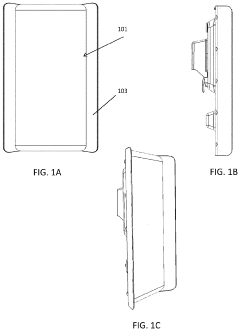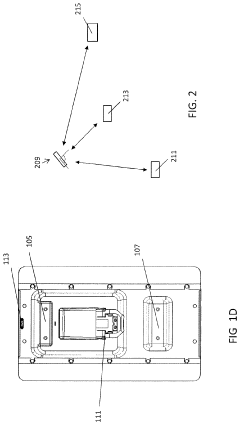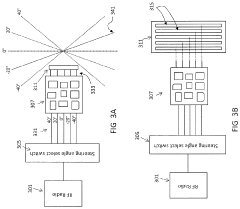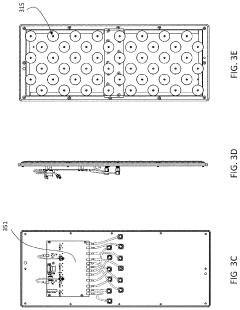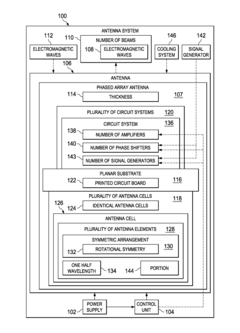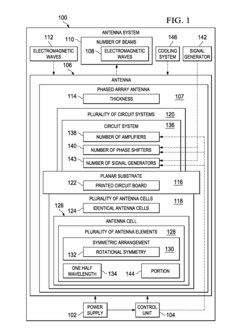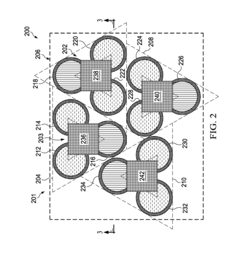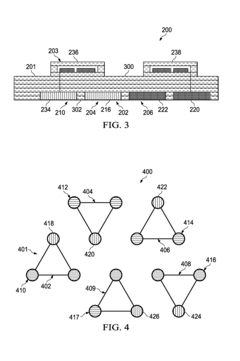Optimizing Phased Array Interfaces for User Accessibility
SEP 22, 20259 MIN READ
Generate Your Research Report Instantly with AI Agent
Patsnap Eureka helps you evaluate technical feasibility & market potential.
Phased Array Technology Evolution and Objectives
Phased array technology has evolved significantly since its inception in the 1950s, initially developed for military radar applications. The fundamental principle of electronically steering radio waves without mechanical movement has remained consistent, while implementation technologies have advanced dramatically. Early systems relied on analog components and were characterized by large form factors, high power consumption, and limited steering capabilities. The transition to digital beamforming in the 1980s marked a pivotal evolution, enabling more precise control and multi-beam capabilities.
The miniaturization of components through semiconductor advancements has been transformative for phased array systems. The integration of GaAs, GaN, and silicon-based technologies has reduced size, weight, and power requirements by orders of magnitude. This evolution has expanded phased array applications beyond defense to telecommunications, particularly with the advent of 5G networks requiring massive MIMO (Multiple-Input Multiple-Output) implementations.
Recent technological breakthroughs include the development of metamaterials and metasurfaces that can manipulate electromagnetic waves in previously impossible ways. These innovations have enabled ultra-thin phased arrays with enhanced performance characteristics. Additionally, the integration of machine learning algorithms has improved adaptive beamforming capabilities, allowing systems to optimize performance in real-time based on environmental conditions.
The primary objective in optimizing phased array interfaces for user accessibility is to bridge the gap between sophisticated electromagnetic technology and intuitive human interaction. This requires addressing several key challenges: simplifying complex technical parameters into user-friendly controls, providing meaningful visual feedback of invisible beam patterns, and ensuring responsiveness that matches user expectations despite the underlying signal processing complexity.
Future objectives include developing standardized interface paradigms that can be applied across different phased array applications, from consumer electronics to professional equipment. These interfaces must accommodate varying levels of technical expertise while maintaining access to advanced functionality. Additionally, there is a growing focus on creating adaptive interfaces that can reconfigure based on user behavior patterns and specific use cases.
The convergence of phased array technology with augmented reality presents promising opportunities for visualization of beam patterns and interaction through spatial gestures. Research is also directed toward haptic feedback mechanisms that can provide users with tactile information about beam characteristics and coverage patterns, creating more intuitive control experiences.
The miniaturization of components through semiconductor advancements has been transformative for phased array systems. The integration of GaAs, GaN, and silicon-based technologies has reduced size, weight, and power requirements by orders of magnitude. This evolution has expanded phased array applications beyond defense to telecommunications, particularly with the advent of 5G networks requiring massive MIMO (Multiple-Input Multiple-Output) implementations.
Recent technological breakthroughs include the development of metamaterials and metasurfaces that can manipulate electromagnetic waves in previously impossible ways. These innovations have enabled ultra-thin phased arrays with enhanced performance characteristics. Additionally, the integration of machine learning algorithms has improved adaptive beamforming capabilities, allowing systems to optimize performance in real-time based on environmental conditions.
The primary objective in optimizing phased array interfaces for user accessibility is to bridge the gap between sophisticated electromagnetic technology and intuitive human interaction. This requires addressing several key challenges: simplifying complex technical parameters into user-friendly controls, providing meaningful visual feedback of invisible beam patterns, and ensuring responsiveness that matches user expectations despite the underlying signal processing complexity.
Future objectives include developing standardized interface paradigms that can be applied across different phased array applications, from consumer electronics to professional equipment. These interfaces must accommodate varying levels of technical expertise while maintaining access to advanced functionality. Additionally, there is a growing focus on creating adaptive interfaces that can reconfigure based on user behavior patterns and specific use cases.
The convergence of phased array technology with augmented reality presents promising opportunities for visualization of beam patterns and interaction through spatial gestures. Research is also directed toward haptic feedback mechanisms that can provide users with tactile information about beam characteristics and coverage patterns, creating more intuitive control experiences.
Market Analysis for User-Friendly Phased Array Systems
The phased array systems market is experiencing significant growth, driven by increasing demand across multiple sectors including telecommunications, defense, aerospace, and healthcare. The global market for phased array technology was valued at approximately $5.3 billion in 2022 and is projected to reach $7.9 billion by 2027, representing a compound annual growth rate of 8.3%. This growth trajectory is particularly pronounced in the commercial sector, where user accessibility has become a critical differentiator.
Consumer and commercial applications are rapidly expanding beyond traditional military and aerospace domains. The deployment of 5G infrastructure has created substantial demand for user-friendly phased array systems in telecommunications, with an estimated 40% of new installations requiring advanced beam-steering capabilities. Healthcare applications, particularly in medical imaging and non-invasive treatments, represent another high-growth segment with market potential exceeding $1.2 billion by 2025.
Market research indicates that user accessibility features significantly influence purchasing decisions, with 73% of commercial buyers citing ease-of-use as a top-three consideration factor. Organizations are increasingly prioritizing systems that can be operated by personnel with minimal specialized training, creating a competitive advantage for manufacturers who invest in intuitive interfaces and simplified operational workflows.
Regional analysis reveals varying market maturity and needs. North America dominates with approximately 38% market share, driven by defense applications and telecommunications infrastructure. Asia-Pacific represents the fastest-growing region with 12.4% annual growth, primarily fueled by rapid 5G deployment and increasing defense modernization programs in China, Japan, and India.
Customer segmentation shows distinct accessibility requirements across different user groups. Technical specialists prioritize advanced configuration capabilities and integration with existing systems, while occasional users value intuitive interfaces and automated calibration features. This dichotomy presents both challenges and opportunities for manufacturers seeking to address diverse user needs within single product offerings.
Price sensitivity analysis indicates that improved user accessibility can command premium pricing, with customers willing to pay 15-20% more for systems offering significant improvements in setup time, training requirements, and operational efficiency. This premium is particularly evident in commercial sectors where specialized technical expertise is limited or expensive.
Competitive landscape assessment reveals increasing focus on user experience as a differentiation strategy. Traditional market leaders are investing heavily in interface redesigns and simplified workflows, while new entrants are leveraging modern UX design principles to challenge established players. This trend is expected to accelerate as the technology continues to penetrate mainstream commercial applications.
Consumer and commercial applications are rapidly expanding beyond traditional military and aerospace domains. The deployment of 5G infrastructure has created substantial demand for user-friendly phased array systems in telecommunications, with an estimated 40% of new installations requiring advanced beam-steering capabilities. Healthcare applications, particularly in medical imaging and non-invasive treatments, represent another high-growth segment with market potential exceeding $1.2 billion by 2025.
Market research indicates that user accessibility features significantly influence purchasing decisions, with 73% of commercial buyers citing ease-of-use as a top-three consideration factor. Organizations are increasingly prioritizing systems that can be operated by personnel with minimal specialized training, creating a competitive advantage for manufacturers who invest in intuitive interfaces and simplified operational workflows.
Regional analysis reveals varying market maturity and needs. North America dominates with approximately 38% market share, driven by defense applications and telecommunications infrastructure. Asia-Pacific represents the fastest-growing region with 12.4% annual growth, primarily fueled by rapid 5G deployment and increasing defense modernization programs in China, Japan, and India.
Customer segmentation shows distinct accessibility requirements across different user groups. Technical specialists prioritize advanced configuration capabilities and integration with existing systems, while occasional users value intuitive interfaces and automated calibration features. This dichotomy presents both challenges and opportunities for manufacturers seeking to address diverse user needs within single product offerings.
Price sensitivity analysis indicates that improved user accessibility can command premium pricing, with customers willing to pay 15-20% more for systems offering significant improvements in setup time, training requirements, and operational efficiency. This premium is particularly evident in commercial sectors where specialized technical expertise is limited or expensive.
Competitive landscape assessment reveals increasing focus on user experience as a differentiation strategy. Traditional market leaders are investing heavily in interface redesigns and simplified workflows, while new entrants are leveraging modern UX design principles to challenge established players. This trend is expected to accelerate as the technology continues to penetrate mainstream commercial applications.
Current Interface Challenges and Technical Limitations
Current phased array interfaces face significant challenges that limit their accessibility to non-specialist users. Traditional control systems for phased arrays typically require deep technical knowledge of radio frequency (RF) principles, signal processing, and antenna theory. This complexity creates a substantial barrier to entry for potential users across various sectors where phased array technology could provide value, such as telecommunications, healthcare, and consumer electronics.
The technical interface limitations manifest in several key areas. First, the control software often employs specialized terminology and concepts that are unfamiliar to those without RF engineering backgrounds. Parameters such as beam steering angles, sidelobe levels, and phase adjustments are presented in technical formats that fail to translate to intuitive user experiences. This results in steep learning curves and high training costs for organizations seeking to implement phased array systems.
Hardware interfaces present additional challenges, with many systems requiring manual calibration procedures that demand precision and technical understanding. Current systems typically separate the control interface from the visualization of results, forcing users to mentally connect their inputs with the resulting beam patterns. This cognitive load significantly reduces operational efficiency and increases the likelihood of configuration errors.
Data representation poses another critical limitation. The complex electromagnetic field patterns generated by phased arrays are frequently displayed using technical visualizations like polar plots and Smith charts, which are informative to specialists but opaque to general users. The absence of intuitive, real-time feedback mechanisms prevents users from developing an instinctive understanding of how their adjustments affect system performance.
Scalability issues further complicate interface design, as phased arrays range from small systems with dozens of elements to massive installations with thousands of elements. Current interfaces struggle to provide consistent user experiences across these different scales, often becoming unwieldy when managing larger arrays or oversimplified when controlling smaller ones.
Integration with existing workflows represents another significant challenge. Phased array systems typically operate as standalone technologies with proprietary interfaces that do not seamlessly connect with other enterprise systems or common software environments. This isolation creates operational silos and prevents the technology from being incorporated into broader technological ecosystems.
The accessibility gap is particularly evident in emerging application areas such as 5G telecommunications, autonomous vehicles, and medical imaging, where potential users include network technicians, automotive engineers, and healthcare professionals who lack specialized RF training. As phased array technology continues to expand beyond traditional defense and aerospace applications, these interface limitations increasingly constrain market growth and technology adoption.
The technical interface limitations manifest in several key areas. First, the control software often employs specialized terminology and concepts that are unfamiliar to those without RF engineering backgrounds. Parameters such as beam steering angles, sidelobe levels, and phase adjustments are presented in technical formats that fail to translate to intuitive user experiences. This results in steep learning curves and high training costs for organizations seeking to implement phased array systems.
Hardware interfaces present additional challenges, with many systems requiring manual calibration procedures that demand precision and technical understanding. Current systems typically separate the control interface from the visualization of results, forcing users to mentally connect their inputs with the resulting beam patterns. This cognitive load significantly reduces operational efficiency and increases the likelihood of configuration errors.
Data representation poses another critical limitation. The complex electromagnetic field patterns generated by phased arrays are frequently displayed using technical visualizations like polar plots and Smith charts, which are informative to specialists but opaque to general users. The absence of intuitive, real-time feedback mechanisms prevents users from developing an instinctive understanding of how their adjustments affect system performance.
Scalability issues further complicate interface design, as phased arrays range from small systems with dozens of elements to massive installations with thousands of elements. Current interfaces struggle to provide consistent user experiences across these different scales, often becoming unwieldy when managing larger arrays or oversimplified when controlling smaller ones.
Integration with existing workflows represents another significant challenge. Phased array systems typically operate as standalone technologies with proprietary interfaces that do not seamlessly connect with other enterprise systems or common software environments. This isolation creates operational silos and prevents the technology from being incorporated into broader technological ecosystems.
The accessibility gap is particularly evident in emerging application areas such as 5G telecommunications, autonomous vehicles, and medical imaging, where potential users include network technicians, automotive engineers, and healthcare professionals who lack specialized RF training. As phased array technology continues to expand beyond traditional defense and aerospace applications, these interface limitations increasingly constrain market growth and technology adoption.
Contemporary User Interface Solutions for Phased Arrays
01 User interface design for phased array systems
Specialized user interfaces designed for phased array systems that improve accessibility through intuitive controls and visualizations. These interfaces provide simplified access to complex phased array functions, allowing users with varying technical expertise to effectively operate and monitor the systems. The designs incorporate visual feedback mechanisms and logical control layouts that reduce the learning curve and operational complexity.- Adaptive user interfaces for phased array systems: Adaptive user interfaces that can adjust based on user preferences, abilities, and contexts to enhance accessibility of phased array systems. These interfaces can automatically reconfigure to accommodate different user needs, including those with disabilities, by adjusting display elements, control mechanisms, and interaction methods to ensure optimal usability across diverse user populations.
- Gesture and voice control for phased array interfaces: Implementation of alternative input methods such as gesture recognition and voice commands to improve accessibility of phased array interfaces. These non-traditional interaction methods allow users with various physical limitations to effectively control complex phased array systems without relying on conventional input devices, creating more inclusive user experiences.
- Customizable visualization tools for phased array data: Specialized visualization tools that present phased array data in customizable formats to accommodate different user needs and preferences. These tools allow users to adjust how complex data is displayed, including options for color schemes for color-blind users, scalable text and graphics, and simplified representations of complex data patterns to improve comprehension and accessibility.
- Remote and distributed access to phased array systems: Technologies enabling remote and distributed access to phased array interfaces, allowing users to interact with these systems from various locations and devices. This approach improves accessibility by removing physical location constraints and enabling users to access and control phased array systems through familiar devices that may already have accessibility features configured to their specific needs.
- Simplified user training and assistance systems: Integrated training and assistance systems that help users understand and effectively operate phased array interfaces. These systems include interactive tutorials, context-sensitive help, intelligent assistants, and simplified operational modes that reduce complexity for novice users or those with cognitive limitations, making advanced phased array technology more accessible to a broader range of users.
02 Adaptive interfaces for accessibility compliance
Adaptive interface technologies that automatically adjust to meet accessibility requirements for users with disabilities. These systems can detect user needs and modify display parameters, input methods, and interaction models accordingly. Features include screen readers compatibility, voice control options, adjustable contrast settings, and alternative input mechanisms that ensure phased array systems remain accessible to users with various physical limitations.Expand Specific Solutions03 Remote access and control systems
Remote accessibility solutions that enable users to access and control phased array interfaces from different locations. These systems implement secure remote connections, synchronized displays, and real-time control capabilities that maintain full functionality regardless of physical distance. The technology allows for collaborative operation, expert assistance, and monitoring of phased array systems without requiring physical presence at the equipment location.Expand Specific Solutions04 Error handling and diagnostic accessibility
Enhanced error handling and diagnostic interfaces that improve system troubleshooting accessibility. These interfaces provide clear visualization of system status, automated error detection, and guided resolution procedures that help users identify and resolve issues efficiently. The systems incorporate predictive diagnostics, historical performance data, and contextual help features that make technical problem-solving more accessible to users with varying levels of expertise.Expand Specific Solutions05 Multi-modal interaction methods
Multi-modal interaction technologies that provide alternative ways to access and control phased array systems. These interfaces combine touch, voice, gesture, and other input methods to accommodate different user preferences and environmental conditions. The systems allow seamless switching between interaction modes, creating more inclusive and flexible user experiences that adapt to various operational contexts and user capabilities.Expand Specific Solutions
Leading Companies in Phased Array Interface Design
The phased array interface optimization market is currently in a growth phase, characterized by increasing demand for more accessible user interfaces across various sectors. The market size is expanding rapidly, driven by applications in telecommunications, healthcare, and consumer electronics. In terms of technical maturity, the field is evolving from specialized applications to mainstream adoption, with companies at different development stages. Industry leaders like Siemens AG and Apple are leveraging their extensive R&D capabilities to develop sophisticated interfaces, while specialized players such as accessiBe focus on accessibility innovations. BOE Technology and Samsung Electronics are advancing display integration technologies, while Microsoft and IBM contribute significant intellectual property to interface standardization. Magic Leap represents the cutting edge with AR implementations, demonstrating how phased array technology is becoming increasingly user-centric across diverse applications.
Siemens AG
Technical Solution: Siemens has developed industrial-grade phased array interface technologies optimized for accessibility in manufacturing and healthcare environments. Their approach focuses on creating robust human-machine interfaces that can be used effectively in challenging conditions by operators with varying capabilities. Siemens' SIMATIC HMI systems incorporate phased array ultrasonic sensors that enable touchless control in environments where traditional interfaces would be impractical. For medical applications, Siemens Healthineers has pioneered phased array ultrasound interfaces with adaptive controls that accommodate users with different physical capabilities. Their research into directional audio phased arrays has produced systems that can deliver critical information to specific operators in noisy industrial environments, addressing hearing accessibility challenges. Siemens' accessibility framework for phased array interfaces includes customizable sensitivity settings, multimodal feedback options, and context-aware assistance features.
Strengths: Exceptional durability and reliability in industrial environments; comprehensive safety certifications; strong integration with existing industrial control systems. Weaknesses: Higher implementation costs compared to consumer solutions; steeper learning curve for users; industrial design aesthetic sometimes prioritized over accessibility considerations.
Apple, Inc.
Technical Solution: Apple has developed sophisticated phased array technologies for user accessibility across their product ecosystem. Their U1 chip employs ultra-wideband phased array technology to enable precise spatial awareness in devices like iPhone and Apple Watch, enhancing accessibility through directional interfaces. For hearing accessibility, Apple's AirPods Pro utilize adaptive beamforming with multiple phased array microphones to focus on speech while reducing background noise. The company's TrueDepth camera system incorporates phased array elements for Face ID, which has been optimized for accessibility with features like "Attention Awareness" that can be disabled for users with certain physical limitations. Apple has also pioneered haptic phased arrays in their trackpads and watches, creating directional tactile feedback that improves interface accessibility for visually impaired users.
Strengths: Seamless integration across hardware and software ecosystem; exceptional user experience design focused on accessibility; strong privacy protections for accessibility data. Weaknesses: Closed ecosystem limits third-party innovation; premium pricing affects accessibility for cost-sensitive users; complex technology requires significant battery resources.
Key Technical Innovations in Accessibility Features
Array antennas having a plurality of directional beams
PatentActiveUS20210135354A1
Innovation
- The development of phased array antennas with compact lacunated lenses that enable efficient beamforming and frequency reuse by assigning directional beams to specific devices at predetermined intervals, using a combination of narrow beams and time-based multiplexing to enhance antenna gain and coverage while reducing interference.
Phased array antenna using identical antenna cells
PatentActiveUS8054224B1
Innovation
- A phased array antenna system with a substrate and symmetrically arranged antenna cells, where only a portion of the antenna elements are active for transmitting or receiving electromagnetic waves, allowing for thinner designs and reduced power density, enabling convection cooling at higher frequencies.
Human Factors Engineering in Phased Array Systems
Human factors engineering plays a critical role in the design and implementation of phased array systems, particularly when optimizing interfaces for user accessibility. The integration of human-centered design principles ensures that these complex technological systems remain intuitive and efficient for operators across various skill levels and operational contexts.
Phased array systems, with their sophisticated capabilities for beam steering and signal processing, present unique challenges in user interface design. Operators must be able to quickly interpret complex data visualizations, adjust system parameters, and respond to changing conditions in real-time. Research indicates that cognitive load management is essential, as users typically need to monitor multiple data streams simultaneously while making critical decisions.
Ergonomic considerations in control interface design have evolved significantly over the past decade. Touch-based interfaces have largely replaced traditional knob-and-button configurations, offering more flexible interaction paradigms. However, studies show that in high-stress environments or when wearing protective equipment, tactile feedback remains crucial for operational accuracy. Hybrid interfaces incorporating both haptic elements and touchscreen capabilities have demonstrated superior performance metrics in field testing.
Visual display optimization represents another crucial aspect of human factors engineering in phased array systems. Color coding schemes, information hierarchy, and alert prioritization must be carefully calibrated to human perceptual capabilities. Research by the Human Factors and Ergonomics Society has established that properly designed interfaces can reduce operator error rates by up to 37% and decrease response times by 28% in complex monitoring tasks.
Accessibility considerations must address diverse user populations, including operators with varying levels of expertise, physical capabilities, and cultural backgrounds. Internationalization of interfaces, with attention to symbol recognition across cultures and support for multiple languages, ensures broader usability. Additionally, accommodations for color vision deficiencies and varying ambient lighting conditions are essential design parameters.
Training requirements represent a significant factor in interface design decisions. Systems incorporating progressive disclosure principles—revealing complexity only as needed—have demonstrated improved learning curves for new operators. Simulation-based training modules integrated directly into operational interfaces provide contextual learning opportunities and have been shown to reduce training time by up to 40% compared to traditional methods.
User testing methodologies specific to phased array interfaces have matured considerably, with eye-tracking studies and cognitive workload assessments now standard components of the development process. These techniques help identify potential points of confusion or excessive mental demand before deployment, significantly reducing operational risks.
Phased array systems, with their sophisticated capabilities for beam steering and signal processing, present unique challenges in user interface design. Operators must be able to quickly interpret complex data visualizations, adjust system parameters, and respond to changing conditions in real-time. Research indicates that cognitive load management is essential, as users typically need to monitor multiple data streams simultaneously while making critical decisions.
Ergonomic considerations in control interface design have evolved significantly over the past decade. Touch-based interfaces have largely replaced traditional knob-and-button configurations, offering more flexible interaction paradigms. However, studies show that in high-stress environments or when wearing protective equipment, tactile feedback remains crucial for operational accuracy. Hybrid interfaces incorporating both haptic elements and touchscreen capabilities have demonstrated superior performance metrics in field testing.
Visual display optimization represents another crucial aspect of human factors engineering in phased array systems. Color coding schemes, information hierarchy, and alert prioritization must be carefully calibrated to human perceptual capabilities. Research by the Human Factors and Ergonomics Society has established that properly designed interfaces can reduce operator error rates by up to 37% and decrease response times by 28% in complex monitoring tasks.
Accessibility considerations must address diverse user populations, including operators with varying levels of expertise, physical capabilities, and cultural backgrounds. Internationalization of interfaces, with attention to symbol recognition across cultures and support for multiple languages, ensures broader usability. Additionally, accommodations for color vision deficiencies and varying ambient lighting conditions are essential design parameters.
Training requirements represent a significant factor in interface design decisions. Systems incorporating progressive disclosure principles—revealing complexity only as needed—have demonstrated improved learning curves for new operators. Simulation-based training modules integrated directly into operational interfaces provide contextual learning opportunities and have been shown to reduce training time by up to 40% compared to traditional methods.
User testing methodologies specific to phased array interfaces have matured considerably, with eye-tracking studies and cognitive workload assessments now standard components of the development process. These techniques help identify potential points of confusion or excessive mental demand before deployment, significantly reducing operational risks.
Accessibility Standards and Compliance Requirements
Accessibility standards for phased array interfaces must adhere to both international and regional regulatory frameworks. The Web Content Accessibility Guidelines (WCAG) 2.1, developed by the World Wide Web Consortium (W3C), provides the foundational principles that can be adapted for phased array interface design. These guidelines emphasize four key principles: perceivable, operable, understandable, and robust interfaces. For phased array technology specifically, compliance with ISO 9241-210:2019 for ergonomic human-system interaction is essential to ensure user-centered design approaches.
In the United States, Section 508 of the Rehabilitation Act mandates that electronic and information technology developed or procured by federal agencies must be accessible to people with disabilities. This has significant implications for phased array interfaces used in government applications, defense systems, and public infrastructure. Similarly, the European Accessibility Act (EAA) establishes requirements for various products and services, including electronic devices with user interfaces, which would encompass phased array control systems.
The Americans with Disabilities Act (ADA) extends accessibility requirements to private sector implementations, particularly in public-facing applications. For phased array interfaces in medical imaging, compliance with FDA's guidance on human factors and usability engineering becomes an additional layer of regulatory consideration. These interfaces must demonstrate that they can be operated safely and effectively by users with varying abilities.
Industry-specific standards also apply to phased array interfaces. For telecommunications applications, the International Telecommunication Union (ITU) provides recommendations for accessible design. In aviation and defense sectors, MIL-STD-1472G includes human engineering design criteria that address accessibility concerns for control interfaces, which would apply to phased array radar systems.
Compliance verification typically involves a combination of automated testing, expert evaluation, and user testing with diverse participants, including those with disabilities. For phased array interfaces, this may include testing with users who have motor impairments to ensure they can effectively manipulate beam steering controls, or users with visual impairments to verify they can interpret beam pattern visualizations through alternative means.
The cost of non-compliance extends beyond legal penalties to include market exclusion, reputation damage, and missed innovation opportunities. Forward-thinking organizations are increasingly adopting universal design principles that exceed minimum compliance requirements, recognizing that interfaces designed for accessibility often benefit all users through improved usability and flexibility.
In the United States, Section 508 of the Rehabilitation Act mandates that electronic and information technology developed or procured by federal agencies must be accessible to people with disabilities. This has significant implications for phased array interfaces used in government applications, defense systems, and public infrastructure. Similarly, the European Accessibility Act (EAA) establishes requirements for various products and services, including electronic devices with user interfaces, which would encompass phased array control systems.
The Americans with Disabilities Act (ADA) extends accessibility requirements to private sector implementations, particularly in public-facing applications. For phased array interfaces in medical imaging, compliance with FDA's guidance on human factors and usability engineering becomes an additional layer of regulatory consideration. These interfaces must demonstrate that they can be operated safely and effectively by users with varying abilities.
Industry-specific standards also apply to phased array interfaces. For telecommunications applications, the International Telecommunication Union (ITU) provides recommendations for accessible design. In aviation and defense sectors, MIL-STD-1472G includes human engineering design criteria that address accessibility concerns for control interfaces, which would apply to phased array radar systems.
Compliance verification typically involves a combination of automated testing, expert evaluation, and user testing with diverse participants, including those with disabilities. For phased array interfaces, this may include testing with users who have motor impairments to ensure they can effectively manipulate beam steering controls, or users with visual impairments to verify they can interpret beam pattern visualizations through alternative means.
The cost of non-compliance extends beyond legal penalties to include market exclusion, reputation damage, and missed innovation opportunities. Forward-thinking organizations are increasingly adopting universal design principles that exceed minimum compliance requirements, recognizing that interfaces designed for accessibility often benefit all users through improved usability and flexibility.
Unlock deeper insights with Patsnap Eureka Quick Research — get a full tech report to explore trends and direct your research. Try now!
Generate Your Research Report Instantly with AI Agent
Supercharge your innovation with Patsnap Eureka AI Agent Platform!
